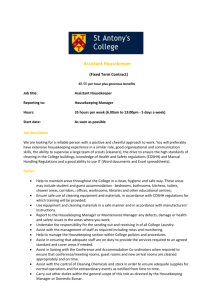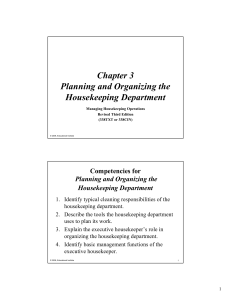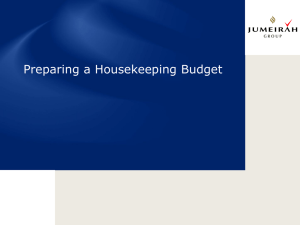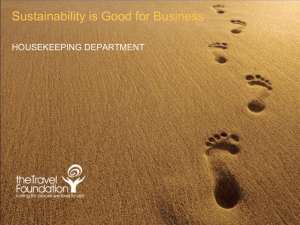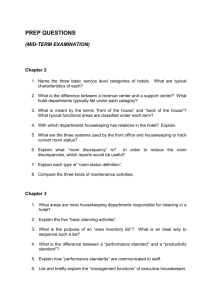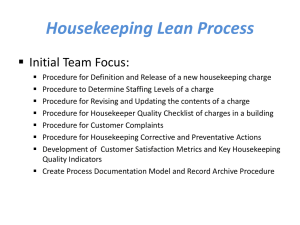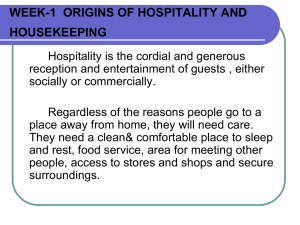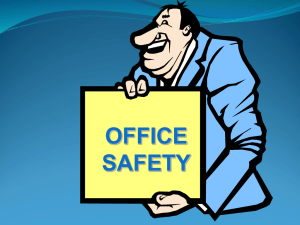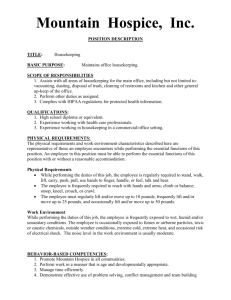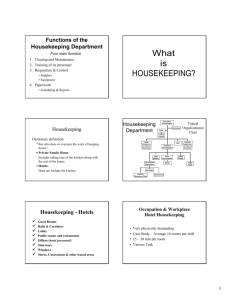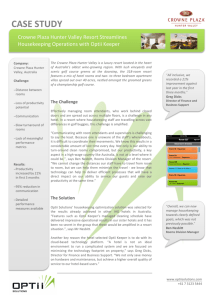Chapter 3
advertisement
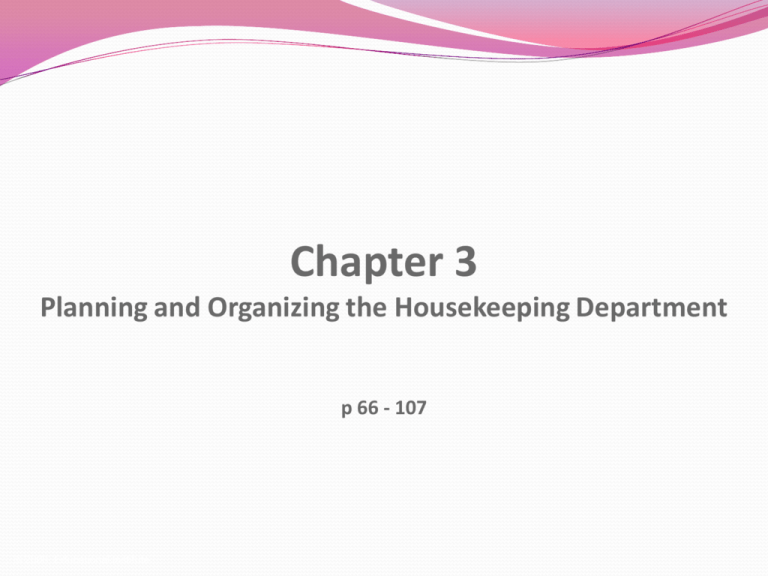
Chapter 3 Planning and Organizing the Housekeeping Department p 66 - 107 © 2008, Educational Institute Key Competencies: Identify typical cleaning housekeeping department. responsibilities of the Describe the tools the housekeeping department uses to plan its work. Explain the executive housekeeper’s role in organizing the housekeeping department. Identify basic management functions of the executive housekeeper. © 2008, Educational Institute 1 Introduction “Like all other managers in a hotel, the executive housekeeper uses available resources to attain objectives set by top management executives. Resources include people, money, time, work methods, materials, energy, and equipment.” These resources are usually limited in supply and thus the most important part of the executive housekeeper’s job is planning how to use the limited resources available to attain the hotel’s objectives. © 2008, Educational Institute 2 Typical Cleaning Responsibilities of the Housekeeping Department Basic responsibilities • Guestrooms • Corridors • Public areas (e.g. Lobby) • Pools and patio areas • Management offices • Storage areas • Linen and sewing rooms • Laundry room • Back-of-the-house areas © 2008, Educational Institute 3 Additional Areas of Responsibility Meeting rooms Dining rooms Banquet rooms Convention exhibit halls Hotel-operated shops Game rooms Exercise rooms It is important to note that Housekeeping’s responsibilities with regards to the Food and Beverage Department may vary from property to property, as the outlets are usually responsible for their own areas. © 2008, Educational Institute 4 The Planning Process Two of the most common documents which are absolutely vital in the housekeeping planning process are: Area Inventory Lists: a list of all items within each area that will need housekeeping’s attention. It is regarded as the first step of the planning process, because it ensures that all cleaning activities are addressed. Frequency Schedule: indicate how often items on area inventory lists are to be cleaned or maintained. These schedules often run on a daily, weekly, biweekly, monthly or bimonthly schedule – depending on the activity. © 2008, Educational Institute 5 Performance and Productivity Standards These two sets of standards are commonplace in any hospitality environment, but are once again vital to the planning processes of the Housekeeping Department. Performance Standard: is a required level of performance that establishes the quality of work that must be done. Productivity Standard: is an acceptable amount of work that must be done within a specific time frame according to an established performance standard. © 2008, Educational Institute 6 Types of Inventory Items Inventory levels for the Housekeeping Department focus on two specific areas: Equipment and Supplies. Of these two types of resources available, there are two categories: Recycled Inventories: stock items that have a relatively limited useful life, but are used over and over in operations. E.g. Linens, equipment items, guest loan items and uniforms. Non-recycled inventories: those items in stock that are consumed or used up during the course of routine housekeeping operations. E.g. Cleaning supplies, guestroom supplies, guest amenities. © 2008, Educational Institute 7 Inventory Par Levels In standard housekeeping operations, an executive housekeeper will often refer to pars and par numbers – which are another vital part to the planning processes. Par Number: refers to the number of items that must be on hand to support daily, routine housekeeping operations. Minimum Quantity: refers to the fewest number of purchase units that should be in stock at any given time. Maximum Quantity: refers to the greatest number of purchase units that should be in stock at any given time. © 2008, Educational Institute 8 Organizing the Housekeeping Department Organizing refers to the executive housekeeper’s responsibility to structure the department’s staff and to divide the work so that everyone gets a fair assignment and all the work can be finished on time. Structuring the department’s staff means establishing the lines of authority and the flow of communication within the department. The two principles that should guide the organization of the department are: Each employee should have only one supervisor Supervisors should have the authority and information necessary to guide the efforts of employees under their direction. © 2008, Educational Institute 9 Organizational Charts These relatively simple charts provide a clear picture of the lines of authority and the channels of communication within the department. These charts, depending on the size of the hotel, can either be very simple or quite complex in nature. The organization chart of the department not only provides for a systematic direction of orders, but also protects employees from being over-directed. A copy of the chart should be placed in an area that is well accessed by the housekeeping staff. (Refer to Exhibits 5 – 7 on pages 84 and 85 for examples) © 2008, Educational Institute 10 Task Lists and Job Descriptions A Task List identifies the tasks that must be performed by an individual occupying a specific position within the department. The tasks on the list should reflect the total job responsibilities of the employee. A Job Description is a detailed list identifying all the key duties of a job as well as reporting relationships, additional responsibilities, working conditions and any necessary equipment and materials. © 2008, Educational Institute 11 Sample Job Description for Room Attendant Basic Function Performs routine duties in the cleaning and servicing of guestrooms and baths under supervision of an inspector. Duties and Responsibilities 1. Enters and prepares the room for cleaning. 2. Makes the bed. 3. Dusts the room and furniture. © 2008, Educational Institute (continued) 12 Sample Job Description for Room Attendant (continued) 4. 5. 6. 7. 8. Replenishes guestroom and bath supplies. Cleans the bathroom. Cleans the closet. Vacuums and rakes the carpet. Checks and secures the room. Relationships Reports directly to the inspector. © 2008, Educational Institute 13 Management Process Planning: using the limited resources available to attain the hotel’s objectives. Organizing: structuring staff and dividing the work for fair assignment and timeous completion. Coordinating: implementing the results of the planning and organizing stages. Staffing: the recruitment of applicants, selecting the best qualified and scheduling thereof. © 2008, Educational Institute 14 Management Process Directing: focusing employee activity on the goals established, using strategies and motivation. Controlling: devising and implementing procedures that protect the hotel’s assets. Evaluating: assessing the extent to which goals have been attained. Presentation Reference: http://www.eiacademic.org/productview.aspx?id=21146&viewId=Powerpoint © 2008, Educational Institute 15
